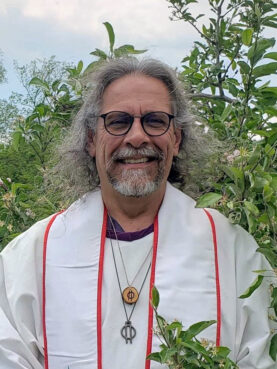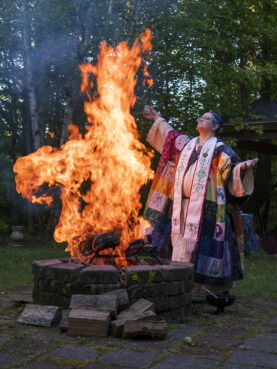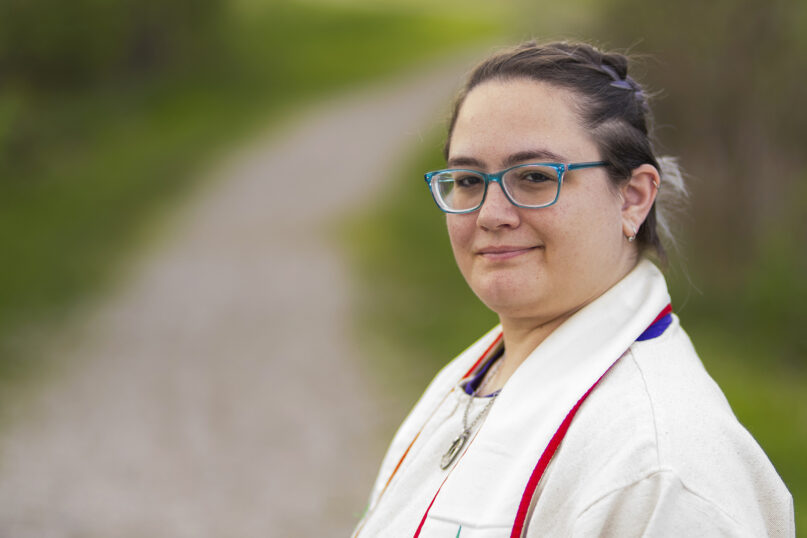(RNS) — As the first millennial and nonbinary archdruid of the national pagan nonprofit church, Ár nDraíocht Féin: A Druid Fellowship, the Rev. Jan Avende is looking forward to advancing the organization’s educational initiatives and technological capabilities, among other endeavors.
Avende, a Columbus, Ohio, resident, was installed as the group’s leader on May 25 in a formal ceremony in Ohio. They are looking forward to bringing their fresh perspective to the role, they told RNS.
“There has been a lot of status quo, a lot of the same,” Avende, 38, said, adding that it has given ADF great stability. However, the organization is “at a tipping point.”
“The world is way more diverse than anyone initially (expected) … and we as a modern polytheist, neopagan tradition need to be where people are.”
ADF was founded in 1983 by Isaac Bonewits, growing out of the fledgling pagan movement, which centers its theology partly on nature reverence. Bonewits and his colleagues first imagined the organization, according to its website, to be “a network of independent scholars interested in legitimate research about the ancient Druids and their Indo-European colleagues.” Education was central to its purpose.

The Rev. Jean Pagano. (Courtesy photo)
Modern Druidry is one of several noncentralized pagan religions, like Wicca, practiced worldwide today.
As the organization grew, ADF evolved into a pagan church with nonprofit status, offering membership, ordination and community. It’s still a volunteer-run organization, but a few of its leaders, including the archdruid, receive a small monthly stipend.
The outgoing archdruid, the Rev. Jean Pagano, was the organization’s eighth member and became its leader in 2016. He was elected to three consecutive three-year terms, ending this year.
Pagano said he recognized a growing need for organizational evolution, and among his accomplishments were updating meeting processes and launching a project to overhaul ADF’s website. However, he’s most well-known for expanding the organization’s visibility worldwide. Before his leadership, ADF was mostly a North American tradition, Avende said. Today, it has 1,024 members and 47 groves — the Druid name for smaller spiritual congregations — in 22 countries and on six continents. Membership has increased by almost 50 in the last year.
While his efforts helped expand membership abroad, that was not necessarily a goal, Pagano said. He sought to build bridges with other Druid organizations, such the Order of Bards, Ovates and Druids and the Anglesey Druid Order, both based in the United Kingdom.
“I believe it is important for Druid leaders to build upon our commonality,” Pagano said. “I would rather have someone say, ‘I’m a Druid.’ And the second question be, ‘What kind of Druid are you?’”
Avende said Pagano “expanded ADF in space,” and now they seek to “expand ADF in time” by modernizing its technology to fulfill its core mission. And as the first millennial archdruid, Avende believes they are uniquely poised to lead this effort. Growing up in a digitally infused culture, Avende understands “the ways people use the internet today to interact,” they said, adding with a laugh, “perhaps not as much as Z or Alpha,” referring to younger generations.

The Rev. Jan Avende makes an offering to Helios, asking the deity to witness their oath as Archdruid of ADF, during their installation into the role on May 25, 2025, in Ohio. (Photo © Rev. Michael J Dangler)
Like many millennials, Avende first discovered paganism in their teens and joined The Ohio State University Pagan Student Association as a college student, and eventually a local Druid grove, the Three Cranes Grove, ADF. They have since served in multiple ADF leadership roles and became credentialed as an ADF priest.
Until recently, paganism has “primarily been a religion of converts,” Avende explained, but that is changing as believers are raising their children in the tradition. As education is a core strength of ADF, it is already in a good position to serve this shifting demographic, they said.
“I am raising my children in the tradition,” they said.
Avende hopes technological upgrades will make learning within the community easier, they said, and more broadly, that ADF becomes a go-to educational organization beyond its own membership. It aims to become a resource for anyone in the pagan community seeking information on shared religious experiences such as pastoral care or spiritual development.
Avende, who is a chaplain at an Ohio trauma hospital, also wants to expand the organization’s interfaith footprint to advance both Druidry and paganism as a movement.
And while they are enthusiastic about ADF’s future, Avende also noted concerns.
“It is hard to be a trailblazer,” they said, speaking specifically about identifying as a nonbinary archdruid. “There is definitely a layer of fear about being that first person and being out about all of it, but it’s who I am.”
Avende said they understand the risk of being “tokenized,” as people may assume they are “speaking for a much broader group” of LGBTQ+ folks. “I know I will have to walk that line carefully,” they said.
While there has been some backlash from “trolls” outside the organization, they said, feedback about their new role has been overwhelmingly positive. Pagano described Avende as a leader who “showed up” and did the hard work, which got them elected.

The Rev. Jan Avende. (Photo © Rev. Michael J Dangler)
Avende hopes their presence will help ADF become a place where “people who are at the edges feel like they can belong,” they added.
Their first order of business is finishing the website upgrade, the project started under Pagano’s leadership. Then, Avende will tackle the organization’s core educational studies program. They will be moving to what Avende called a learning management system that will allow for more teacher-student interaction with more levels of educational instruction and will cater to diverse learning styles.
Avende emphasized the need for ADF to continue to encourage spiritual exploration in its membership and within the greater community.
Reciprocity is a core value of the organization, they continued. “Everything we do needs to be in relation with everything around us,” they said. “Let’s find a way for people to connect.”



